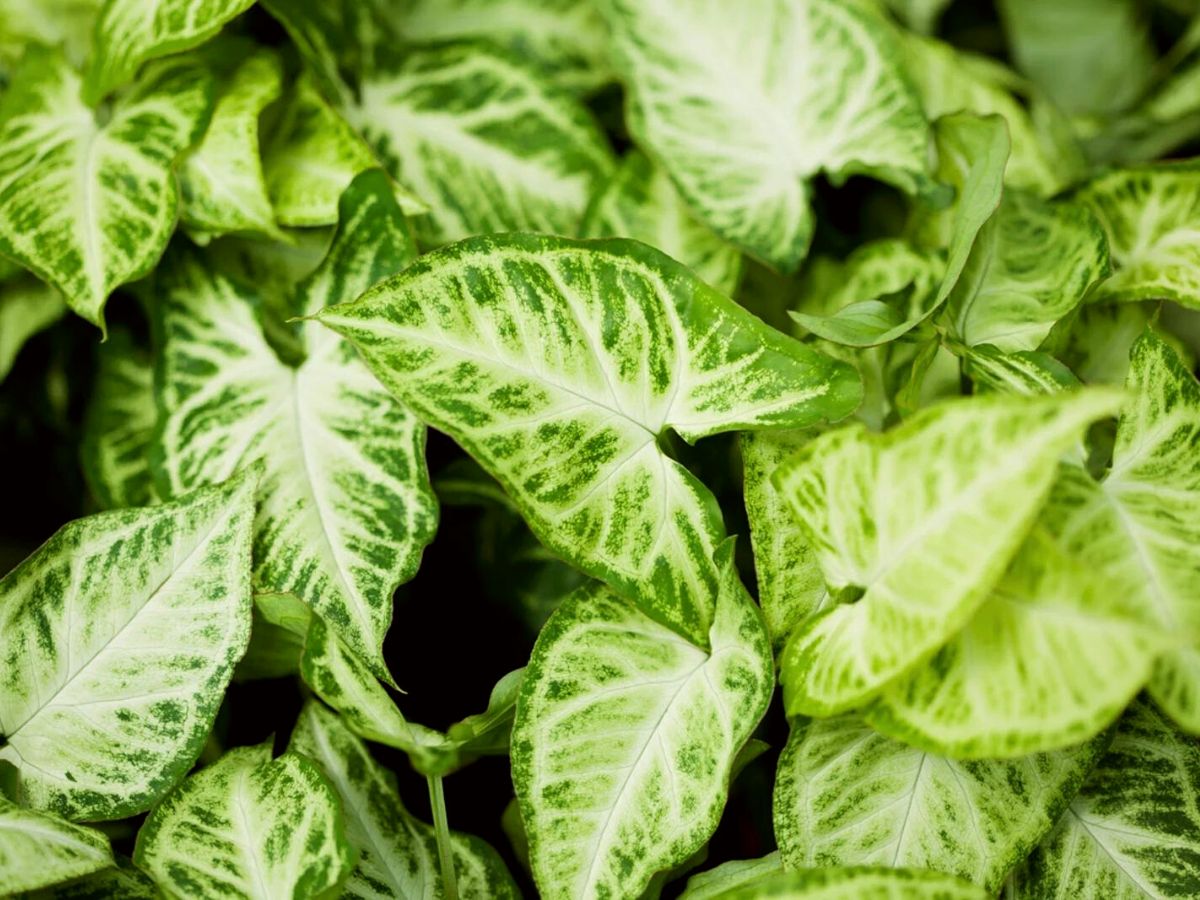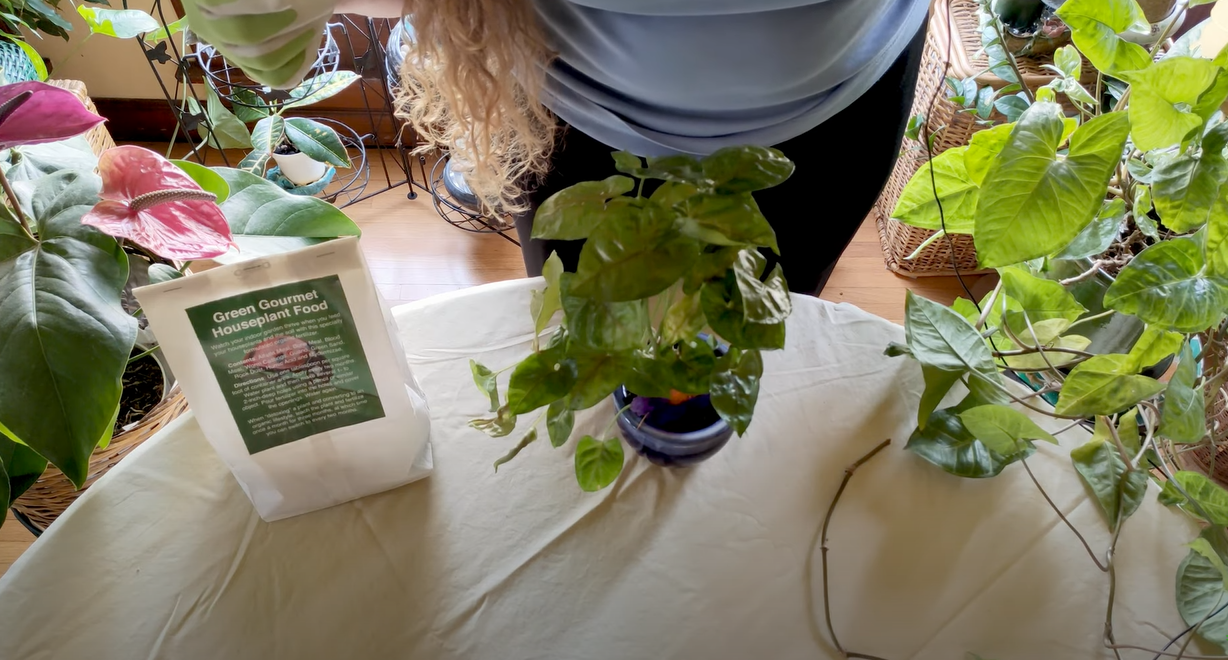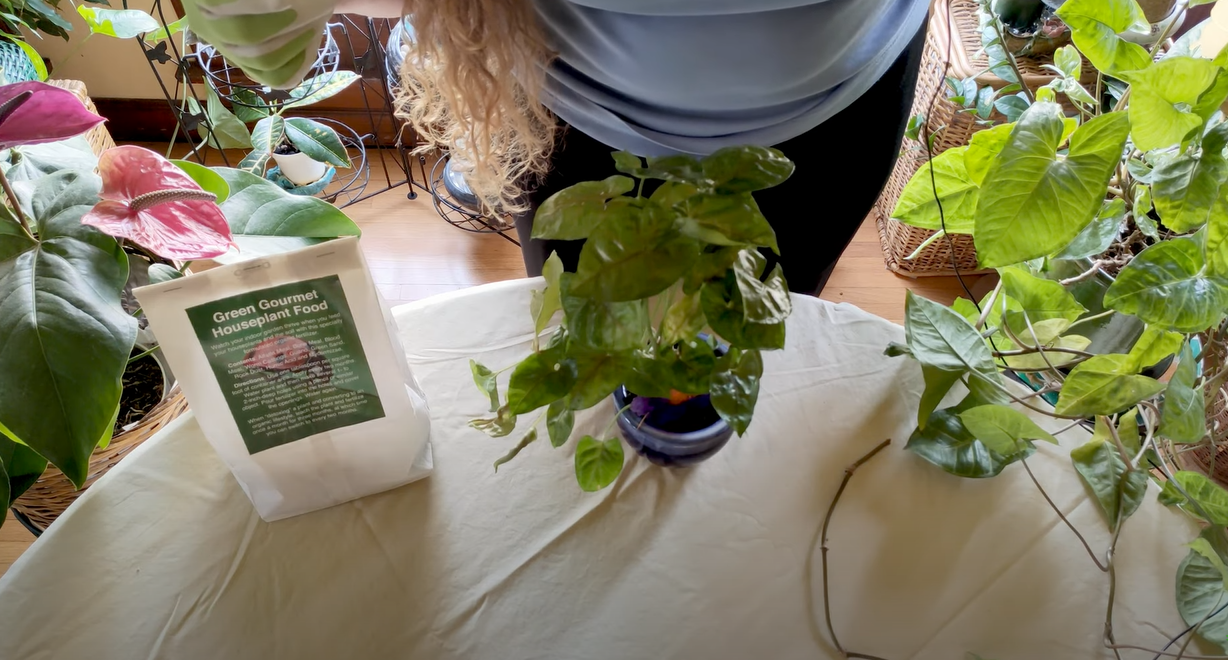Best Fertilizers for Growing a Healthy Arrowhead Plant: Arrowhead plants, with their striking foliage, are a popular choice for both indoor and outdoor gardens. But to ensure these beauties thrive, understanding their nutritional needs and selecting the right fertilizer is crucial.
This guide delves into the world of arrowhead plant fertilization, providing a comprehensive understanding of the best fertilizer types, application techniques, and troubleshooting tips for achieving optimal growth.
From identifying the key nutrients arrowhead plants require to mastering fertilizer application techniques, we’ll cover everything you need to know to cultivate healthy and vibrant arrowhead plants. We’ll also explore the signs of nutrient deficiency, discuss fertilizer recommendations for specific arrowhead varieties, and delve into the nuances of fertilizing arrowhead plants in different growing environments.
Understanding Arrowhead Plant Needs
Arrowhead plants, known for their distinctive arrow-shaped leaves, are relatively low-maintenance houseplants that thrive with minimal care. However, understanding their specific needs ensures optimal growth and vibrant foliage.
Nutritional Requirements
Arrowhead plants require a balanced diet of essential nutrients for healthy growth. They need a good supply of macronutrients like nitrogen (N), phosphorus (P), and potassium (K) to support their overall development. These nutrients are crucial for various functions:
- Nitrogen (N)promotes vigorous leaf growth and vibrant green color.
- Phosphorus (P)plays a vital role in root development, flowering, and seed production.
- Potassium (K)is essential for strong stems, disease resistance, and overall plant health.
Soil pH
The ideal soil pH for arrowhead plants is slightly acidic to neutral, ranging from 6.0 to 7.0. This pH range ensures optimal nutrient availability for the plant’s roots.
Drainage
Arrowhead plants are susceptible to root rot if they sit in waterlogged soil. Therefore, proper drainage is crucial for their well-being. The soil should be well-draining, allowing excess water to escape readily. Using a potting mix with perlite or vermiculite can enhance drainage and aeration.
Best Fertilizer Types
Arrowhead plants, known for their striking foliage, thrive with proper nutrition. Selecting the right fertilizer is crucial for promoting healthy growth and vibrant coloration. Understanding the different types of fertilizers available and the specific nutrients arrowhead plants require can help you choose the best option for your plant.
Key Nutrients for Arrowhead Plants, Best Fertilizers for Growing a Healthy Arrowhead Plant
Arrowhead plants, like most plants, need a balanced diet of essential nutrients. The three primary nutrients they require are:
- Nitrogen (N): Nitrogen promotes healthy leaf growth and vibrant green coloration. A deficiency can lead to yellowing leaves and stunted growth.
- Phosphorus (P): Phosphorus is vital for root development, flowering, and overall plant health. A deficiency can result in weak stems and poor root growth.
- Potassium (K): Potassium plays a role in water regulation, disease resistance, and overall plant strength. A deficiency can lead to wilting and brown leaf tips.
Liquid Fertilizers
Liquid fertilizers are readily available and easy to apply. They are typically formulated to provide a balanced mix of essential nutrients.
While proper fertilization is crucial for a healthy arrowhead plant, it’s also important to remember that propagation can quickly increase your collection. If you’re looking to expand your arrowhead plant family, How to Propagate Your Arrowhead Plant With Ease is a great resource.
Once you’ve established new plants, you can then focus on providing the optimal fertilizer to support their growth and ensure they thrive in your home.
- Benefits: Liquid fertilizers are quickly absorbed by the plant, making them ideal for providing immediate nutrients. They are also versatile and can be applied directly to the soil or mixed with water for foliar feeding.
- Drawbacks: Liquid fertilizers need to be applied more frequently than other types, as they don’t provide long-lasting nutrition. They can also be more expensive than granular fertilizers.
Granular Fertilizers
Granular fertilizers are solid pellets that are applied to the soil. They release nutrients gradually over time, providing sustained nourishment.
- Benefits: Granular fertilizers are convenient and require less frequent application compared to liquid fertilizers. They also tend to be more cost-effective.
- Drawbacks: Granular fertilizers may take longer to be absorbed by the plant compared to liquid fertilizers. They can also be difficult to apply evenly, potentially leading to uneven nutrient distribution.
Slow-Release Fertilizers
Slow-release fertilizers are designed to release nutrients over an extended period. They are typically granules coated with a protective layer that slowly dissolves over time.
- Benefits: Slow-release fertilizers provide consistent nutrition over several weeks or months, reducing the need for frequent applications. They also minimize the risk of nutrient burn.
- Drawbacks: Slow-release fertilizers can be more expensive than other types. They may not provide immediate nutrients, which can be a concern for plants experiencing nutrient deficiencies.
Organic Fertilizers
Organic fertilizers are derived from natural sources, such as compost, manure, and bone meal. They provide nutrients to the soil and improve its overall health.
- Benefits: Organic fertilizers are environmentally friendly and promote soil biodiversity. They also contribute to better soil structure and water retention.
- Drawbacks: Organic fertilizers may not provide readily available nutrients compared to synthetic fertilizers. They can also be more difficult to apply evenly and may attract pests.
Fertilizer Application Techniques
Applying fertilizer to your arrowhead plant is crucial for its healthy growth and development. However, it’s essential to do it correctly to avoid over-fertilizing, which can damage the plant. This section will guide you on the appropriate techniques for applying fertilizer to your arrowhead plant.
Fertilizer Application Techniques
The most common method of applying fertilizer to arrowhead plants is by using a liquid fertilizer diluted in water. This method is easy to use and ensures that the fertilizer is evenly distributed throughout the soil. Here are the steps to follow:
- Choose a fertilizer specifically formulated for houseplants. Avoid using fertilizers designed for outdoor plants, as they may contain higher concentrations of nutrients that could harm your arrowhead plant.
- Dilute the fertilizer according to the manufacturer’s instructions. Over-fertilizing can lead to root burn and other problems.
- Apply the diluted fertilizer to the soil around the plant, ensuring that it doesn’t come into direct contact with the leaves.
- Water the plant thoroughly after applying the fertilizerto help the nutrients reach the roots.
Frequency of Fertilizer Application
The frequency of fertilizer application depends on the arrowhead plant’s growth stage. During the active growing season (spring and summer), arrowhead plants require more nutrients to support their rapid growth.
- During the active growing season (spring and summer), fertilize your arrowhead plant every two to four weeks.
- During the dormant season (fall and winter), reduce the frequency of fertilization to once a month or even less.
Fertilization Schedule for Arrowhead Plants
Here is a suggested fertilization schedule for arrowhead plants throughout the year:
Season |
Fertilization Frequency |
|---|---|
Spring |
Every 2-4 weeks |
Summer |
Every 2-4 weeks |
Fall |
Once a month |
Winter |
Once every 6-8 weeks or less |
Signs of Nutrient Deficiency

While arrowhead plants are generally hardy and adaptable, they can still exhibit signs of nutrient deficiencies if their soil lacks essential nutrients. These deficiencies can manifest in various ways, affecting the plant’s growth, appearance, and overall health. Understanding these signs is crucial for identifying and addressing nutrient imbalances before they become severe.
Nutrient Deficiency Symptoms in Arrowhead Plants
Recognizing nutrient deficiencies in arrowhead plants is essential for maintaining their health and vigor. Observing changes in leaf color, growth patterns, and overall plant appearance can provide valuable insights into potential nutrient imbalances. The following table summarizes the key symptoms associated with common nutrient deficiencies in arrowhead plants:
Nutrient |
Symptoms |
Solutions |
|---|---|---|
Nitrogen (N) |
|
|
Phosphorus (P) |
|
|
Potassium (K) |
|
|
Fertilizer Recommendations for Specific Arrowhead Varieties: Best Fertilizers For Growing A Healthy Arrowhead Plant

Arrowhead plants, with their striking foliage, come in a variety of cultivars, each with its own unique growth habits and nutrient requirements. While the general fertilizer recommendations discussed previously apply to most arrowhead varieties, some cultivars benefit from tailored approaches to ensure optimal growth and vibrant coloration.
Fertilizer Needs of Popular Arrowhead Varieties
Different arrowhead plant varieties have distinct nutrient needs, influenced by factors such as growth rate, leaf color, and overall size. Understanding these variations allows for precise fertilizer application to maximize plant health and visual appeal.
- ‘Black Beauty’: Known for its deep, almost black leaves, ‘Black Beauty’ requires ample nitrogen to maintain its vibrant coloration. Additionally, sufficient potassium is crucial for strong root development and overall plant vigor. Fertilizing this variety with a balanced liquid fertilizer diluted to half strength during the growing season (spring and summer) is recommended.
- ‘Pink Princess’: This variety is prized for its variegated leaves, featuring pink and green patterns. ‘Pink Princess’ benefits from a fertilizer rich in phosphorus, which promotes healthy root growth and vibrant leaf coloration. Applying a phosphorus-rich fertilizer during the growing season, while ensuring adequate nitrogen for overall growth, will enhance its striking appearance.
- ‘Albo-marginata’: Featuring leaves with white margins, ‘Albo-marginata’ benefits from a fertilizer rich in magnesium, which contributes to the development of healthy chlorophyll and vibrant green coloration. Supplementing with a magnesium-rich fertilizer during the growing season will enhance the contrast between the white margins and the green center of the leaves.
Best Time of Year to Fertilize Arrowhead Varieties
The optimal time for fertilizing arrowhead plants aligns with their active growth period. Generally, arrowhead plants thrive during the spring and summer months when temperatures are warm and sunlight is abundant. During this period, they require a regular supply of nutrients to support vigorous growth and foliage production.
Providing your arrowhead plant with the right nutrients is crucial for its growth and health. Balanced fertilizers, rich in nitrogen, phosphorus, and potassium, are ideal. For optimal results, consider following the comprehensive guide on Top 5 Tips for Caring for an Arrowhead Plant Indoors which covers essential aspects of plant care.
This will ensure your arrowhead plant thrives and flourishes, rewarding you with its beautiful foliage.
- Spring and Summer: These months are ideal for fertilizing arrowhead plants. The warm temperatures and increased sunlight stimulate active growth, making the plants more receptive to nutrient uptake. Apply fertilizer every 2-4 weeks during this period, following the recommended dilution rates for the specific fertilizer.
- Autumn and Winter: During the cooler months, arrowhead plants enter a period of dormancy, with reduced growth rates. Fertilizer application should be reduced or completely ceased during this time. Excessive fertilization during dormancy can lead to nutrient buildup in the soil, potentially causing root damage.
Fertilizing Arrowhead Plants in Different Growing Environments
Arrowhead plants, known for their striking foliage, thrive in various environments, but their fertilizer needs can vary depending on their growing conditions. Understanding how to tailor your fertilization approach to the specific environment will help your arrowhead flourish.
Fertilizer Application Techniques for Indoor and Outdoor Arrowhead Plants
The method of fertilizer application differs significantly for arrowhead plants grown indoors versus outdoors. Indoor plants, being confined to pots, require a more controlled approach to fertilization. Outdoor arrowhead plants, on the other hand, benefit from a more natural approach, mimicking the conditions they would experience in their natural habitat.
Indoor Arrowhead Plants
- Liquid Fertilizer:Liquid fertilizers are the most common and convenient option for indoor arrowhead plants. They are readily absorbed by the roots and allow for precise control over the amount of nutrients delivered. Dilute the fertilizer according to the manufacturer’s instructions and apply it to the soil every 2-4 weeks during the growing season (spring and summer).
- Slow-Release Granules:Slow-release granules offer a more sustained release of nutrients, reducing the frequency of fertilization. These granules are typically applied once every 3-4 months, ensuring a steady supply of nutrients over a longer period.
Outdoor Arrowhead Plants
- Organic Matter:Incorporating organic matter, such as compost or manure, into the soil provides a slow and steady release of nutrients. This approach mimics the natural processes that occur in the wild and promotes a healthy soil ecosystem.
- Granular Fertilizer:Granular fertilizers can be applied around the base of the plant, allowing the nutrients to gradually seep into the soil. This method is particularly effective for outdoor plants as it minimizes the risk of over-fertilization.
Impact of Growing Conditions on Fertilizer Needs
Sunlight, temperature, and humidity all play a role in influencing the fertilizer requirements of arrowhead plants.
Sunlight
Arrowhead plants grown in bright, indirect sunlight tend to have a higher nutrient demand. They utilize nutrients more rapidly to support their growth and photosynthesis. Conversely, plants in low-light conditions may require less fertilizer as their growth rate is slower.
Temperature
Warmer temperatures stimulate plant growth, leading to increased nutrient consumption. During the warmer months, arrowhead plants may need more frequent fertilization to meet their increased demands. Conversely, during colder periods, their growth slows down, and fertilizer requirements decrease.
Humidity
High humidity levels can lead to increased nutrient leaching from the soil. In humid environments, it may be necessary to fertilize more frequently to compensate for nutrient loss.
Tailored Fertilizer Recommendations for Different Growing Environments
Here are some specific fertilizer recommendations for arrowhead plants grown in various environments:
Indoor Arrowhead Plants
- Bright, Indirect Light:A balanced liquid fertilizer, diluted to half strength, can be applied every 2 weeks during the growing season.
- Low Light:A diluted liquid fertilizer, applied every 4 weeks during the growing season, is sufficient.
Outdoor Arrowhead Plants
- Full Sun:A slow-release granular fertilizer, applied once in spring and once in summer, provides sustained nutrient release.
- Partial Shade:A balanced liquid fertilizer, diluted to half strength, can be applied every 4 weeks during the growing season.
Alternatives to Chemical Fertilizers
While chemical fertilizers provide a quick boost of nutrients, there are several natural alternatives that can nourish your arrowhead plant without the potential risks associated with synthetic chemicals. These natural methods promote soil health, support beneficial microorganisms, and can be more sustainable in the long run.
Compost Tea
Compost tea is a liquid fertilizer made by steeping compost in water. It is rich in beneficial microorganisms, including bacteria and fungi, that help break down organic matter and make nutrients available to plants.
- Compost tea can improve soil structure and water retention, leading to healthier plant growth.
- It can also help suppress plant diseases and pests by introducing beneficial microorganisms to the soil.
To make compost tea, you will need:
- A bucket or container with a lid
- Compost
- Water
- An air pump (optional)
Instructions:
- Fill the container with water, leaving some space at the top.
- Add compost to the water, using a ratio of about 1 cup of compost per gallon of water.
- Stir the mixture well and cover the container with a lid.
- Optionally, use an air pump to aerate the mixture, which will encourage the growth of beneficial microorganisms.
- Let the mixture steep for 24-48 hours, stirring occasionally.
- Strain the compost tea through a cheesecloth or coffee filter before applying it to your arrowhead plant.
Worm Castings
Worm castings, also known as vermicompost, are the excrement of earthworms. They are a rich source of nutrients, including nitrogen, phosphorus, potassium, and micronutrients.
- Worm castings improve soil structure and aeration, promoting healthy root growth.
- They can also help suppress plant diseases and pests.
You can apply worm castings to your arrowhead plant as a top dressing or mix them into the potting mix.
Homemade Fertilizer Recipes
There are many homemade fertilizer recipes that you can use to nourish your arrowhead plant. Here are a few examples:
- Banana Peel Tea:Steep banana peels in water for a few days to create a liquid fertilizer rich in potassium and phosphorus.
- Eggshell Fertilizer:Crush eggshells into a powder and sprinkle them around your arrowhead plant. The calcium in the eggshells will help strengthen the plant’s cell walls.
- Coffee Grounds Fertilizer:Coffee grounds are a good source of nitrogen and can help improve soil drainage.
Benefits of Using Natural Fertilizers
- Improved Soil Health:Natural fertilizers improve soil structure, water retention, and nutrient availability, leading to healthier plant growth.
- Environmental Sustainability:Natural fertilizers are derived from renewable resources and do not contribute to pollution or environmental damage.
- Reduced Risk of Chemical Build-up:Using natural fertilizers avoids the risk of chemical build-up in the soil, which can harm plants and the environment.
Drawbacks of Using Natural Fertilizers
- Slower Nutrient Release:Natural fertilizers release nutrients more slowly than chemical fertilizers, which may not be ideal for plants with high nutrient demands.
- Potential for Pests and Diseases:Natural fertilizers can sometimes attract pests or diseases if they are not properly composted or handled.
- Limited Nutrient Availability:Natural fertilizers may not provide all the nutrients that your arrowhead plant needs, especially if your soil is deficient in certain nutrients.
Conclusion

With the right fertilizer and proper care, your arrowhead plants will flourish, showcasing their stunning foliage and adding a touch of tropical elegance to your space. Remember, understanding your arrowhead plant’s needs and choosing the appropriate fertilizer is key to unlocking their full potential.
So, embrace the knowledge gained from this guide, and watch your arrowhead plants thrive under your expert care.
Query Resolution
How often should I fertilize my arrowhead plant?
The frequency of fertilization depends on the growth stage of your arrowhead plant. During active growth periods, fertilize every 2-4 weeks. During the dormant period, reduce fertilization to once a month or even stop altogether.
What are the signs of over-fertilization in arrowhead plants?
Over-fertilization can lead to leaf tip burn, stunted growth, and root damage. Signs include brown or yellow leaf tips, wilting, and a salty residue on the soil surface.
Can I use coffee grounds as fertilizer for my arrowhead plant?
Coffee grounds are slightly acidic and can help improve soil drainage, but they are not a complete fertilizer. Use them sparingly as a soil amendment, but don’t rely on them as the sole source of nutrients.
